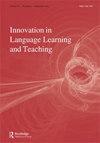通过远程协作协商职前英语教师的身份取向
IF 4.6
3区 教育学
Q1 EDUCATION & EDUCATIONAL RESEARCH
Innovation in Language Learning and Teaching
Pub Date : 2023-03-15
DOI:10.1080/17501229.2022.2085280
引用次数: 2
摘要
随着语言学习和教学中多模式平台的日益普及,远程协作已成为呼叫教学研究的一个动态分支领域。虽然目前的研究大多集中在双语和双文化交流上,但教师身份的多面性并没有得到足够的重视。为了解决这一差距,57名教师候选人与来自欧洲大学的4名教师一起参加了为期8周的远程合作项目。方法引用文献[d] . 2006。识别和评估跨文化能力作为国际化的学生成果。国际教育研究,10(3):241-266。[M. J. 1993]。走向民族相对主义:跨文化敏感性的发展模式。《跨文化体验教育》,R. Michael Paige主编,第21-71页。Yarmouth, ME: Intercultural Press]发展模型,通过(a)同步模式生成的数据分析了教师候选人的身份谈判。研究结果表明,多元文化和多语言认同产生的动力有助于提高跨文化交际能力,教师候选人的跨文化发展表现为(a)跨文化适应,(b)特定文化的认同取向,(c)性别社会化和(d)文化与技术的相互作用。这项研究为英语从业者在语言课堂上培养跨文化交际能力提供了一些启示,并为即将到来的研究提供了具体成果,将远程协作作为宝贵的资产。本文章由计算机程序翻译,如有差异,请以英文原文为准。
Negotiating pre-service EFL teachers’ identity orientations through telecollaboration
ABSTRACT Purpose Telecollaboration has become a dynamic subfield of CALL studies with the increasing availability of multimodal platforms in language learning and teaching. Although current studies mostly have focused on bilingual and bicultural exchanges, affordances of multi-faceted teacher identity have not received considerable attention. To address this gap, 57 teacher candidates took part in an eight-week telecollaboration project with four instructors from European universities. Method Drawing on [Deardorff, D. K. 2006. “Identification and Assessment of Intercultural Competence as a Student Outcome of Internationalization.” Journal of Studies in International Education 10 (3): 241–266.] process orientation and [Bennett, M. J. 1993. “Towards Eethnorelativism: A Developmental Model of Iintercultural Sensitivity.” In Education for the Intercultural Experience, edited by R. Michael Paige, 21–71. Yarmouth, ME: Intercultural Press] developmental models, teacher candidates’ identity negotiations were analysed through the data generated on (a)synchronous modes. Findings and Originality Findings suggest that dynamics resulting from multicultural and multilingual identity contribute to higher intercultural communicative competence, and teacher candidates’ intercultural development is manifested through their (a) intercultural adjustment, (b) culture-specific identity orientations, (c) gender socialisation and (d) culture and technology interplay. This study provides several implications for EFL practitioners to foster intercultural communicative competence in language classes and utilise telecollaboration as a valuable asset with concrete outcomes for upcoming studies.
求助全文
通过发布文献求助,成功后即可免费获取论文全文。
去求助
来源期刊

Innovation in Language Learning and Teaching
LINGUISTICS-
CiteScore
6.90
自引率
6.70%
发文量
54
期刊介绍:
Innovation in Language Learning and Teaching is an international refereed journal devoted to innovative approaches to methodologies and pedagogies in language learning and teaching. It publishes research articles, review articles and book/materials reviews. It draws on a range of disciplines that share a focus on exploring new approaches to language learning and teaching from a learner-centred perspective. It will appeal to anyone interested in the development of, research into or practical application of new methodologies in language teaching and learning.
 求助内容:
求助内容: 应助结果提醒方式:
应助结果提醒方式:


